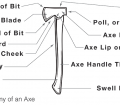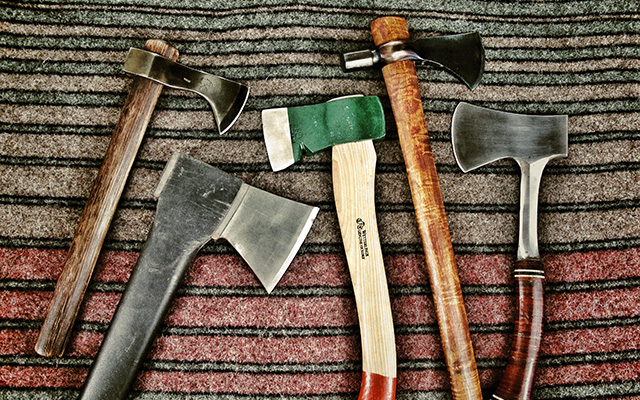If I had to choose a single cutting tool to take with me into the backcountry, it would be a good straight handled tomahawk with a hammer-polled head. Easily replaceable handle, removable head for cutting and skinning, light weight, easy carry, the list goes on. The uses you get from a good hawk exceed almost every other cutting tool out there, and it also doubles as a pretty darn good defensive tool if the need arises. Axes have plenty of uses as well, and can do almost everything a hawk can do, with only a few exceptions. I will outline the pros and cons of each later, but first let’s discuss the why of having an ax or hawk in the field.
Steel composition can make a world of difference in the field. Any sharpening or edge repair that you need to perform will be greatly affected but the metallurgy of the ax head
As mentioned in part one of our series on axes and hawks, man has been using these tools for a very long time, and the renewed interest in them tells us that they will be around for a long while. With so many offerings out there, it can be a bit overwhelming when it comes to selecting the right tool for your needs. I have created a list of questions to ask yourself before beginning your search, and with the knowledge you will get from this series, you should be well on your way to picking out the perfect tool.
• What will I be using this for? Do I need to fell a tree or just chop kindling? Will I be splitting wood or simply pounding in some tent stakes? Determine the specific intended uses, and work on finding the tool that can perform as many of these tasks as possible.
• How will I be carrying it? Belt, pack, horse, sled, vehicle? Having a conveyance will make a huge difference in the size of ax you carry. Having the ability to carry a large felling ax in a conveyance will allow you to carry a smaller ax on your person if you need to have a broader span of tool usage.
• What environment will you be in? Will you need to build large fires in a colder, wetter environment or will you only need it for smaller fires and/or trapping? Think: shelter stakes vs. wood for a warmth fire for 4 people.
• What other tools you be carrying? If you are carrying a relatively large sheath knife, then a small hand ax is not necessary. You can perform most tasks with a large sheath knife that you can with a hand ax. If you have a good folding saw, then you can use that for most cutting of limbs and small branches.
Once you have answered these questions, you can reference the available options and determine the best tool for your needs. Some things to consider:
• Overall size is an obvious consideration, but length and weight are where you really need to look. For length in a pack ax, I prefer the Pit-to-Palm method. The ax should extend from your armpit to the palm of your hand. That length allows me to perform any task I need from an ax without more length than needed. I can two-hand the ax for felling and splitting but also use it for finer tasks without the head being too big or heavy. My pack ax is 26” overall and is 2.2lbs. It is the largest I would carry without a conveyance, and may be a bit big for some. Heavier head weight can lead to deeper chops per swing, but also means more effort to carry and swing the ax.
• Grind is another factor in ax selection. I prefer a Scandinavian or “low flat” grind on the head. It allows for felling and finer work, and is pretty decent at splitting. A more wedge shaped “convex” grind is not as good for felling, and will require extra work to bring down a tree than with a flatter grind. A convex grind is great for splitting and will hold an edge for longer, but will be harder to sharpen in the field. The Scandinavian grind is, in my opinion, the perfect pack ax grind, and works well enough on everything but splitting large amounts of cut wood.
• Steel composition can make a world of difference in the field. Any sharpening or edge repair that you need to perform will be greatly affected but the metallurgy of the ax head. Higher carbon content will also allow for greater material dispersal when using a ferro rod. Modern ax heads are typically going to be good enough for your needs in the field. If you spend the money on the right tool, you can rest assured that the metal will be of a nominal composition for that balance of edge retention and “sharpenability”.
With all of that said, I would like to mention a few other things to consider when searching for your ax. There are several ways to personalize your ax, but there are even more ways to ruin it or reduce its effectiveness. I am not a big fan of lanyards on an ax, but a short loop of paracord or leather thong for hanging is perfectly fine. Also, if you want to wrap the handle of your ax with anything, be sure to test it extensively before heading to the field. Something that will grind your hand into a pulp is not a good trade-off for having cordage on hand. Narrower handles on hawks can benefit from a paracord or leather wrap, but I would not wrap an ax handle.
I have seen some older pictures of measurement markings burned into the back of the handle. I tried this with my forest ax and found it to be a handy addition for trap building and other trivial tasks that one would normally have to guess-timate with. This would be a moot point if you decide to wrap your handle in athletic tape, as some have, but can’t hurt as long as you don’t burn too deeply into the wood and create a weak point.
Selecting the right tool for the job, as outlined above, can be pretty simple so long as you know the answers to the questions. But what if you don’t? What if you had to pick one and stick with it no matter what? How would you choose? While a hawk is smaller, light, and versatile, it lacks the heft of a good ax and will require you to expend more energy to cut the same amount of wood. At a time when calories are at a premium. You could perform the same chopping or splitting with a good forest ax, but will have to carry the extra weight. A difference of 3-5lbs. Choose wisely.
Lastly, a bit about covers. You can use a full head cover or a simple bit cover but I would strongly recommend using a bit cover. It frees up your hammer poll and covers the edge, which increases the safety quite a bit. One of the worst injuries you can sustain in the field is an ax wound. No need to increase the chances of that happening when you can find bit covers for almost any well-made ax on the market.
Now that we have established a baseline for selecting the proper tool for your needs, we will discuss care and maintenance in part 3 of this series.



